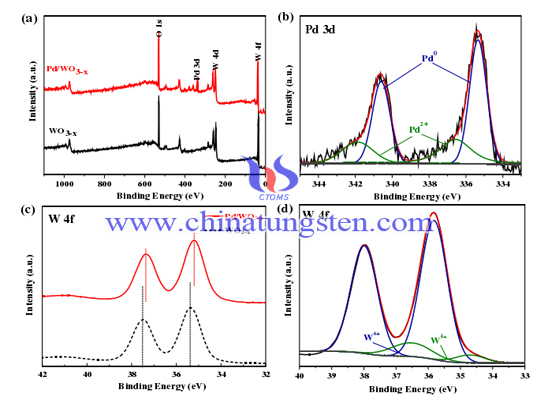Palladium / Tungsten Oxide Composite XPS Spectra
- Details
- Category: Tungsten Information
- Published on Thursday, 01 March 2018 11:11
The elemental valence state and composition of the prepared palladium / tungsten oxide composite can be measured by XPS spectroscopy. The XPS score of the palladium / tungsten oxide composite clearly shows that the resulting composite contains tungsten, oxygen and palladium, demonstrating the successful synthesis of the palladium / tungsten oxide composite.
As you can see from the spectrum, the two less intense peaks at 335.3 e V and 340.6 e V are the characteristic peaks. While the two more intense peaks at 336.6 eV and 341.9 eV are the characteristic peaks of palladium. Most of the palladium ions are reduced to palladium nanoparticles. Defective tungsten oxide shows a certain reduction ability. This method of using in situ reduction of the reducing ability of the support to obtain the noble metal nanoparticles is feasible. Comparing the XPS spectra of the obtained Pd with those of the standard element peaks, it was found that the signal peak of palladium 3d in the palladium / tungsten oxide composite migrated to the low energy region by about 0.3 eV.

his shift in electron-binding energy is influenced by the size of the palladium nanoparticles and the support, a phenomenon that accounts for the strong metal-support interactions in palladium / tungsten oxide composites. This strong interaction can effectively enhance the catalytic performance of the catalyst. Comparing the XPS spectra before and after loading, the peak shifted to a lower energy region after loading the palladium nanoparticles. This is because free electrons are transferred from the defect tungsten oxide to the palladium nanoparticles. This also proves that there is a strong interaction between palladium nanoparticles and tungsten oxide nanowires.

- Tungsten Oxide Manufacturer & Supplier, Chinatungsten Online: www.tungsten-oxide.com
- Tungsten News & Prices of China Tungsten Industry Association: www.ctia.com.cn
- Molybdenum News & Price: news.molybdenum.com.cn
- Tel.: 86 592 5129696; Fax: 86 592 5129797; Email: sales@chinatungsten.com



 sales@chinatungsten.com
sales@chinatungsten.com